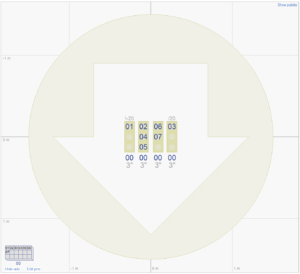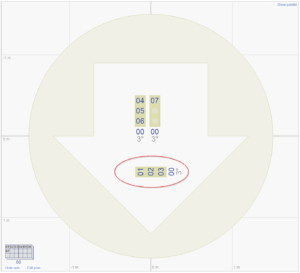If there’s only one type of rack that matches an effect in the show, then the “Racks > Add racks for show” function and the addressing functions will assign the effect to that kind of rack, obviously, but if there are multiple types of racks that match an effect in the show, which rack should the functions choose? This question often arises for companies that use fan racks and straight racks in the same show, or different kinds of racks for finale chains than for the regular shells in the show. Some companies also have racks of specific lengths to match chains of the same length. For all these cases, you can control what kinds of racks are used for specific shells with the “Rack Type Default” and “Rack Type” fields that you can unhide in the effects window and the script window from the blue gear menus.
The Rack Type is an optional matching condition. If a rack has a non-empty Rack Type, then it will only match effects in the script that have the same Rack Type. Thus to make a set of fanned effects in the show get assigned to fan racks, instead of regular straight racks, you can set the Rack Type Default field of the fan racks in the effect window to “fan” (or any other word of your choice), and then set the Rack Type field of the fanned rows in the script window that you want to be assigned to these racks to “fan” also. The matching condition will cause the fan racks to be used for these fanned effects in the show!
The example in Figure 1 shows the default rack layout for a show that includes a trident of three shells in a fan, plus four additional shells straight up. Since no Rack Type was specified, the “Addressing > Add racks for show” function just adds regular straight racks for all the shells, tilting the racks as required for angled shells.

Figure 1 – Without “Rack Type”, tilted racks may be used for fanned effects
If you specify the Rack Type of “fan” for the three trident shells in the script window (leaving the Rack Type of the other shells blank), and specify the Rack Type Default of your fan rack that has tubes fanned out, then the fan rack will be used for those shells, as shown in Figure 2. Comparing Figure 1 and Figure 2, you can see that Figure 1 shows two tilted racks on the left and right sides, whereas Figure 2 doesn’t show any tilted racks. The fan rack in Figure 2 is rotated sideways so that its fanned out tubes are aligned with the angles of the shell trajectories.

Figure 2 – The “Rack Type” field can force fan racks to be used for the fanned effects
The Rack Type field can be used for any circumstance in which you want to specify the kind of rack that is used for specific effects in the show. The circumstances relating to fans are usually dependent on the angles of the effects, obviously, rather than the type of effects, because the angles are the reason you are choosing the fan rack in the first place. You can also use the Rack Type field to control what racks are used for specific types of effects.
You may be wondering why the Rack Type field is called “Rack Type Default” in the effects window, and just “Rack Type” in the script window. It’s a small difference, but it does have meaning. Most of the properties shown in the effects window are intrinsic properties of effects, meaning that every instance of the effect in the show has the exact value specified in the effects window. For intrinsic properties, if you change the property in the effects window, the change automatically applies to all of the effects in the script that reference it.
Because the Rack Type can depend on the circumstance (you set the Rack Type to “fan” for fanned effects but leave it blank for non-fanned effects), the Rack Type values in the script can be different for different rows referring to the same effect in the effect window. Thus the Rack Type values can’t just be references to an intrinsic property of the effect definition, or they would all be same in the script, and you therefore wouldn’t be able to change them in the script.
The field in the effect window is called “Rack Type Default” because that is the initial value for the “Rack Type” of the effect when it is inserted into the script, even though you can change it in the script after it is inserted.
